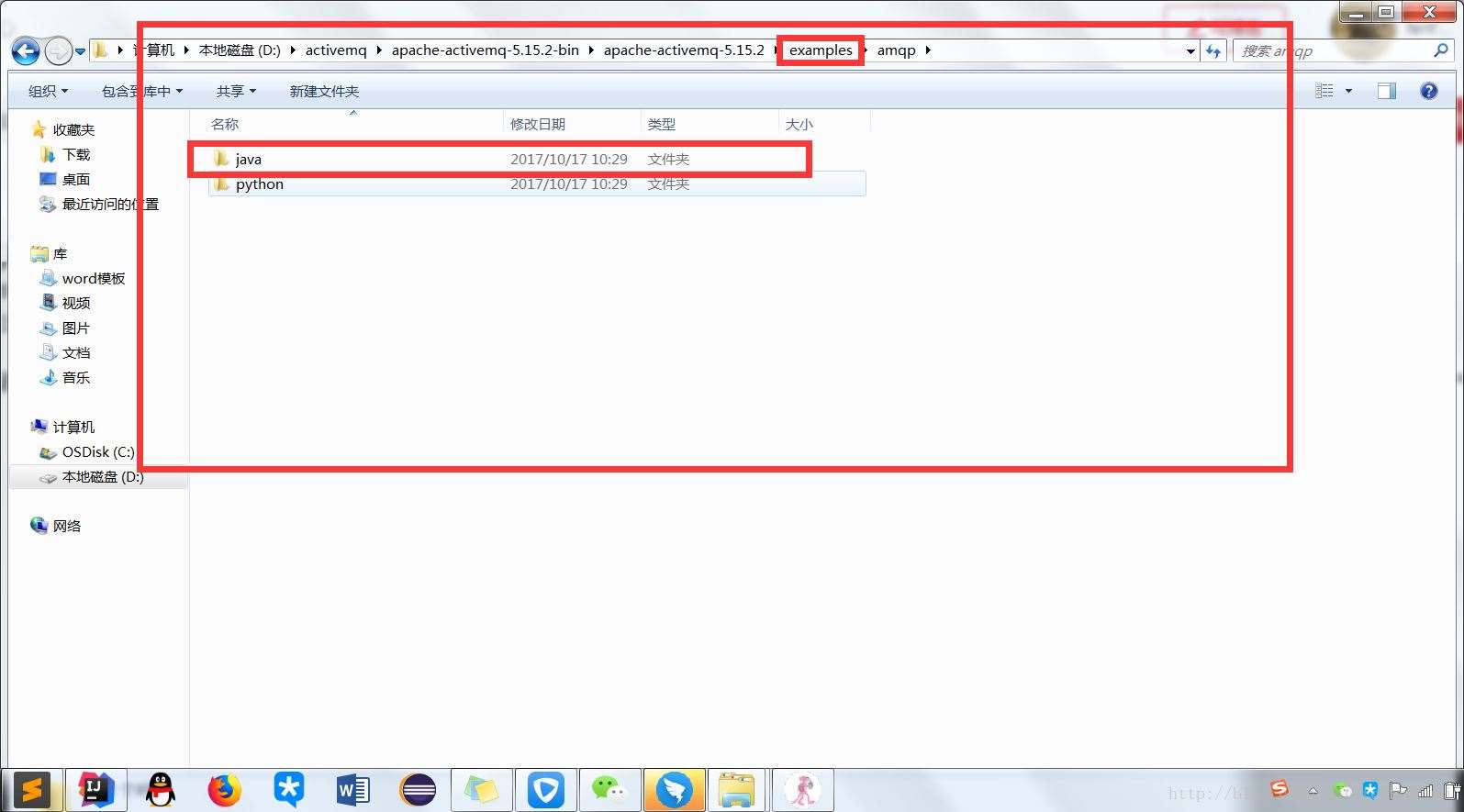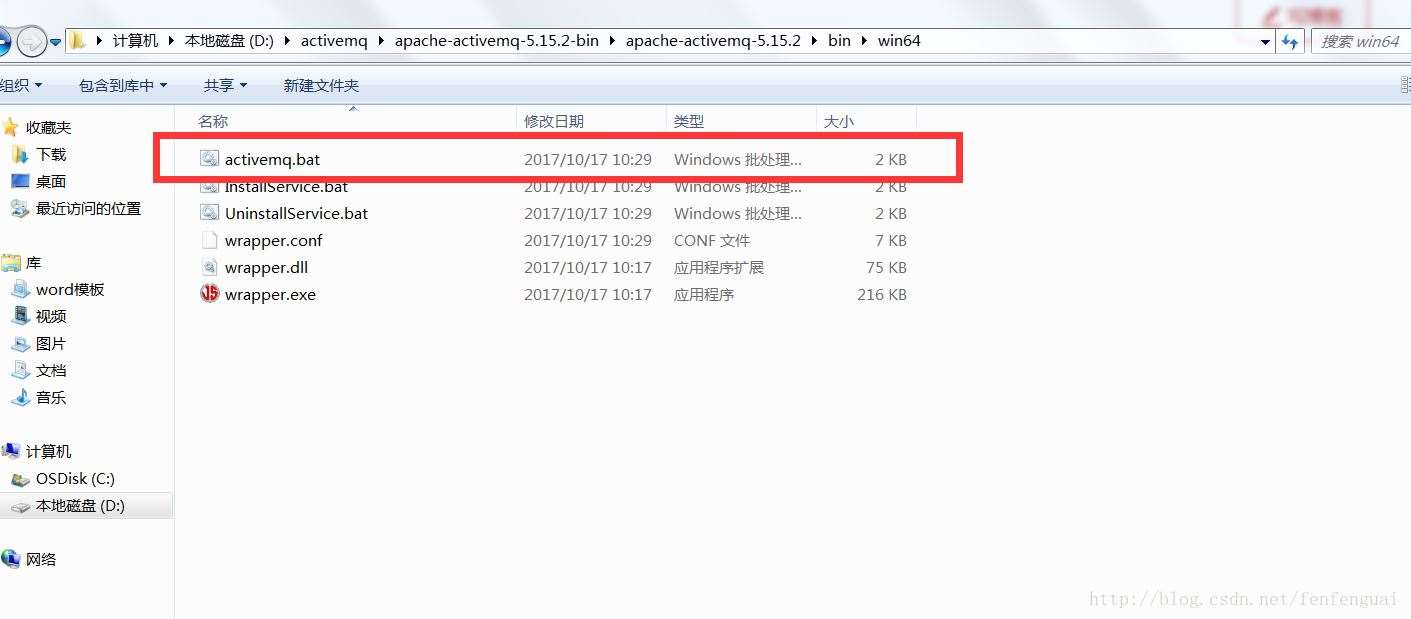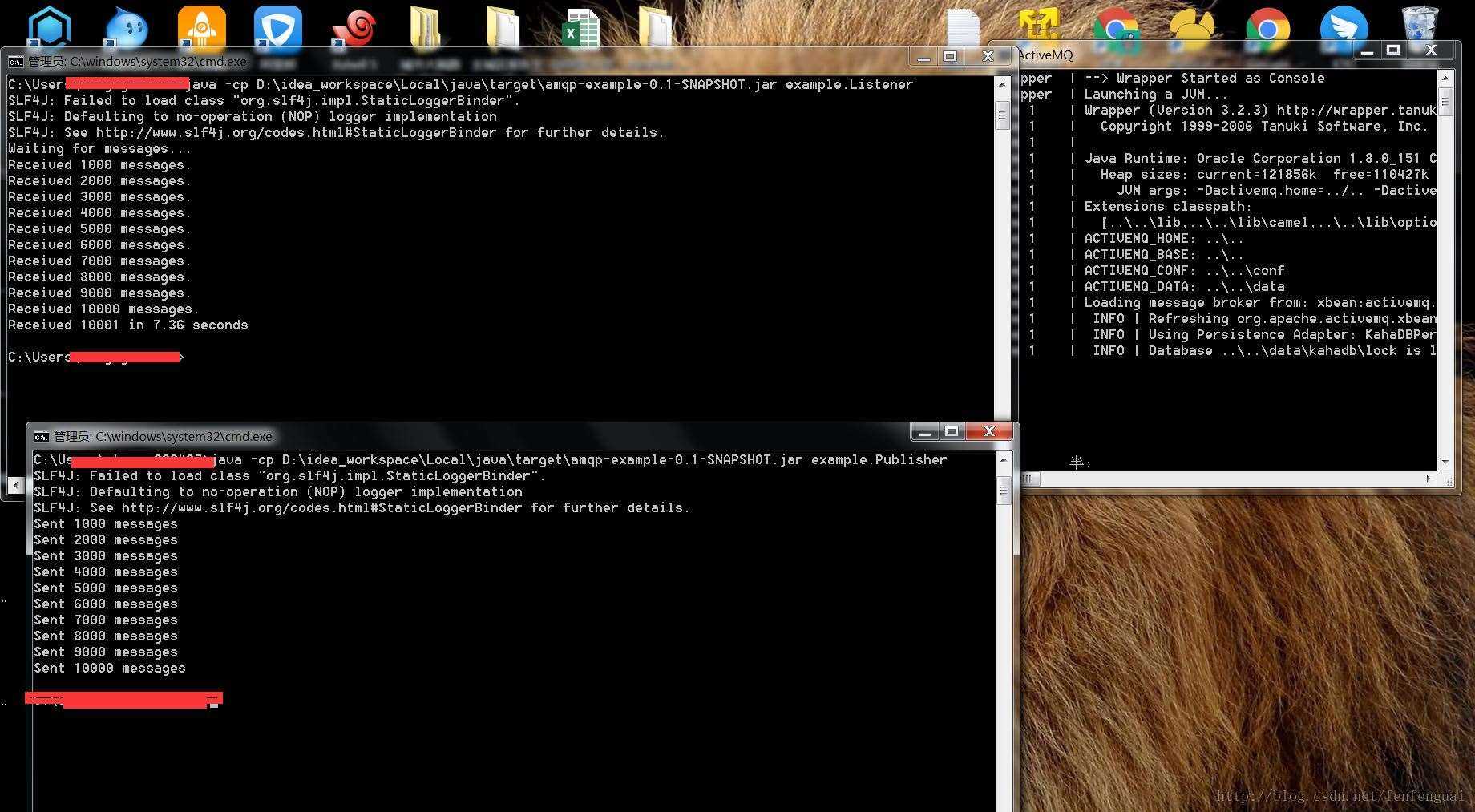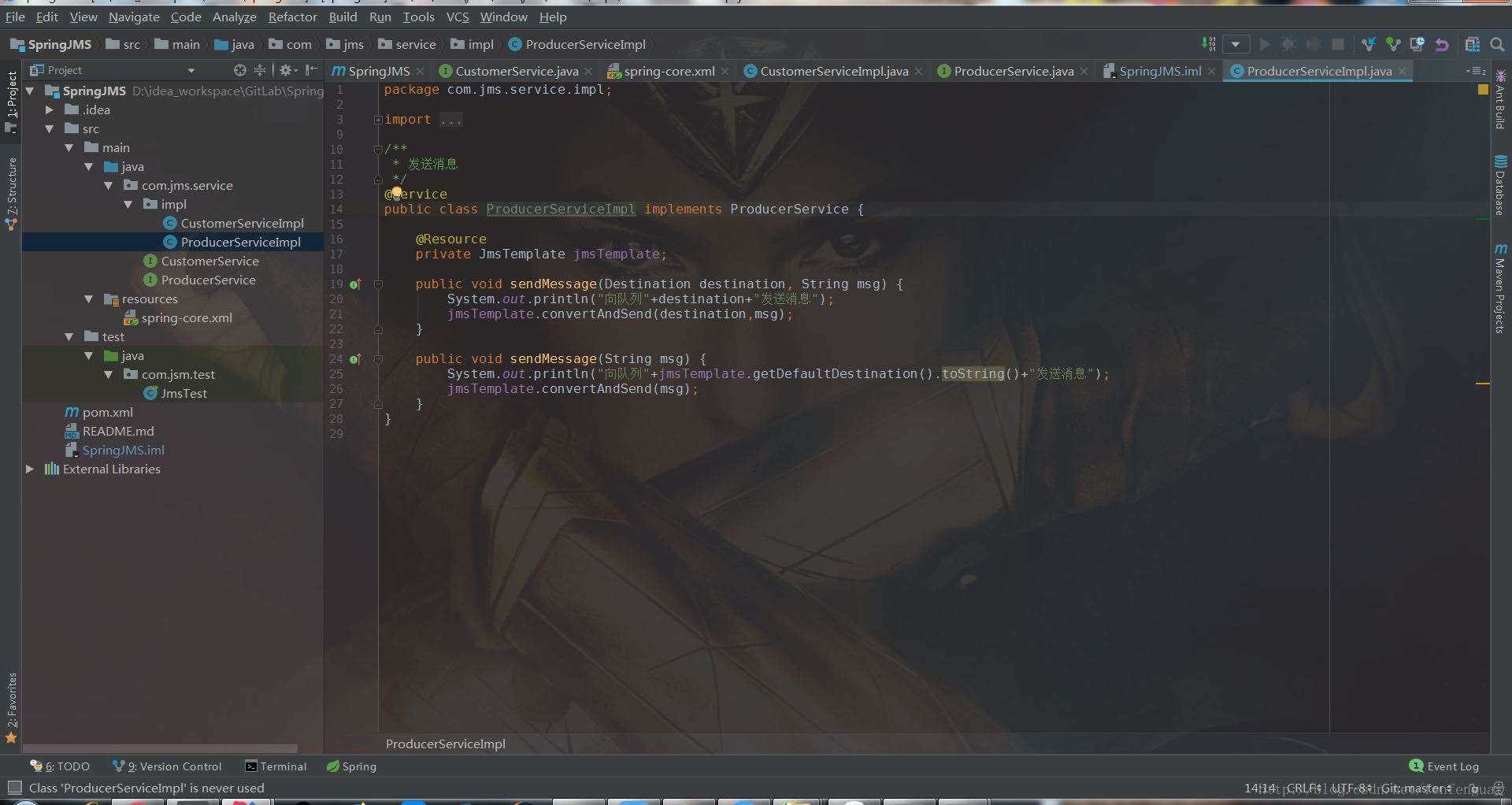- ubuntu12.04环境下使用kvm ioctl接口实现最简单的虚拟机
- Ubuntu 通过无线网络安装Ubuntu Server启动系统后连接无线网络的方法
- 在Ubuntu上搭建网桥的方法
- ubuntu 虚拟机上网方式及相关配置详解
CFSDN坚持开源创造价值,我们致力于搭建一个资源共享平台,让每一个IT人在这里找到属于你的精彩世界.
这篇CFSDN的博客文章java实现消息队列的两种方式(小结)由作者收集整理,如果你对这篇文章有兴趣,记得点赞哟.
实现消息队列的两种方式 。
apache activemq官方实例发送消息 。
直接在apache官网http://activemq.apache.org/download-archives.html下载ActiveMQ源码 。
下载解压后拿到java代码实例 。

然后倒入ide 。
如下:

请认真阅读readme.md文件,大致意思就是把项目打成两个jar包,然后启动服务,然后同时运行打的两个jar包,然后就能看到具体的调用信息。打jar包时直接利用maven打就行了,不用修改代码.
启动服务:


利用spring消息模板发送消息 。
spirng对apache activemq提供了很好的支持 。

生成者代码:
|
1
2
3
4
5
6
7
8
9
10
11
12
13
14
15
16
17
18
19
20
21
22
23
24
25
26
27
28
|
package
com.jms.service.impl;
import
com.jms.service.producerservice;
import
org.springframework.jms.core.jmstemplate;
import
org.springframework.stereotype.service;
import
javax.annotation.resource;
import
javax.jms.destination;
/**
* 发送消息
*/
@service
public
class
producerserviceimpl
implements
producerservice {
@resource
private
jmstemplate jmstemplate;
public
void
sendmessage(destination destination, string msg) {
system.out.println(
"向队列"
+destination+
"发送消息"
);
jmstemplate.convertandsend(destination,msg);
}
public
void
sendmessage(string msg) {
system.out.println(
"向队列"
+jmstemplate.getdefaultdestination().tostring()+
"发送消息"
);
jmstemplate.convertandsend(msg);
}
}
|
消费者代码:
|
1
2
3
4
5
6
7
8
9
10
11
12
13
14
15
16
17
18
19
20
21
22
23
24
25
26
27
28
29
30
31
|
package
com.jms.service.impl;
import
com.jms.service.customerservice;
import
org.springframework.jms.core.jmstemplate;
import
org.springframework.stereotype.service;
import
javax.annotation.resource;
import
javax.jms.destination;
import
javax.jms.jmsexception;
import
javax.jms.textmessage;
@service
public
class
customerserviceimpl
implements
customerservice {
@resource
private
jmstemplate jmstemplate;
/**
* 接收消息
* @param destination
*/
public
void
receive(destination destination) {
textmessage textmessage = (textmessage) jmstemplate.receive(destination);
try
{
system.out.println(
"从队列》"
+destination.tostring()+
"成功获取消息》"
+textmessage.gettext());
}
catch
(jmsexception e) {
e.printstacktrace();
}
}
}
|
spring配置代码 。
|
1
2
3
4
5
6
7
8
9
10
11
12
13
14
15
16
17
18
19
20
21
22
23
24
25
26
27
28
29
30
31
32
33
34
35
36
37
38
39
40
41
42
43
44
45
46
47
48
49
|
<?xml version=
"1.0"
encoding=
"utf-8"
?>
<beans xmlns=
"http://www.springframework.org/schema/beans"
xmlns:xsi=
"http://www.w3.org/2001/xmlschema-instance"
xmlns:context=
"http://www.springframework.org/schema/context"
xmlns:mvc=
"http://www.springframework.org/schema/mvc"
xsi:schemalocation="http:
//www.springframework.org/schema/beans
http:
//www.springframework.org/schema/beans/spring-beans.xsd
http:
//www.springframework.org/schema/context
http:
//www.springframework.org/schema/context/spring-context.xsd
http:
//www.springframework.org/schema/mvc
http:
//www.springframework.org/schema/mvc/spring-mvc.xsd
">
<!-- 启动包扫描功能,以便注册带有
@controller
、
@service
、
@repository
、
@component
等注解的类成为spring的bean -->
<context:component-scan base-
package
=
"com.jms.service"
> </context:component-scan>
<!-- 配置根视图 -->
<!--<mvc:view-controller path=
"/"
view-name=
"index"
/>-->
<!--启用注解-->
<mvc:annotation-driven />
<!-- 视图层配置 -->
<!--<bean
class
=
"org.springframework.web.servlet.view.internalresourceviewresolver"
>-->
<!--<property name=
"prefix"
value=
"/web-inf/view/"
/>-->
<!--<property name=
"suffix"
value=
".jsp"
/>-->
<!--</bean>-->
<!-- 配置jms连接工厂 -->
<bean id=
"connectionfactory"
class
=
"org.apache.activemq.activemqconnectionfactory"
>
<property name=
"brokerurl"
value=
"tcp://localhost:61616"
/>
</bean>
<!-- 定义消息队列(queue) -->
<bean id=
"queuedestination"
class
=
"org.apache.activemq.command.activemqqueue"
>
<!-- 设置消息队列的名字 -->
<constructor-arg>
<value>queue1</value>
</constructor-arg>
</bean>
<!-- 配置jms模板(queue),spring提供的jms工具类,它发送、接收消息。 -->
<bean id=
"jmstemplate"
class
=
"org.springframework.jms.core.jmstemplate"
>
<property name=
"connectionfactory"
ref=
"connectionfactory"
/>
<property name=
"defaultdestination"
ref=
"queuedestination"
/>
<property name=
"receivetimeout"
value=
"10000"
/>
</bean>
</beans>
|
测试代码 。
|
1
2
3
4
5
6
7
8
9
10
11
12
13
14
15
16
17
18
19
20
21
22
23
24
25
26
27
|
package
com.jsm.test;
import
com.jms.service.customerservice;
import
com.jms.service.producerservice;
import
org.junit.test;
import
org.springframework.context.support.classpathxmlapplicationcontext;
import
javax.jms.destination;
/**
* 消息队列测试类
*/
public
class
jmstest {
@test
public
void
producertest(){
classpathxmlapplicationcontext springcontext =
new
classpathxmlapplicationcontext(
new
string[]{
"classpath:spring-core.xml"
});
producerservice producerservice = (producerservice)springcontext.getbean(
"producerserviceimpl"
);
customerservice customerservice = (customerservice)springcontext.getbean(
"customerserviceimpl"
);
destination destination = (destination)springcontext.getbean(
"queuedestination"
);
producerservice.sendmessage(
"测试消息队列"
);
customerservice.receive(destination);
}
}
|
测试结果 。

代码地址 。
https://github.com/wahnn/springjms https://gitee.com/wahnn/springjms 。
以上就是本文的全部内容,希望对大家的学习有所帮助,也希望大家多多支持我.
原文链接:https://blog.csdn.net/fenfenguai/article/details/79257928 。
最后此篇关于java实现消息队列的两种方式(小结)的文章就讲到这里了,如果你想了解更多关于java实现消息队列的两种方式(小结)的内容请搜索CFSDN的文章或继续浏览相关文章,希望大家以后支持我的博客! 。
我一直在阅读有关汇编函数的内容,但对于是使用进入和退出还是仅使用调用/返回指令来快速执行,我感到很困惑。一种方式快而另一种方式更小吗?例如,在不内联函数的情况下,在汇编中执行此操作的最快(stdcal
我正在处理一个元组列表,如下所示: res = [('stori', 'JJ'), ('man', 'NN'), ('unnatur', 'JJ'), ('feel', 'NN'), ('pig',
最近我一直在做很多网络或 IO 绑定(bind)操作,使用线程有助于加快代码速度。我注意到我一直在一遍又一遍地编写这样的代码: threads = [] for machine, user, data
假设我有一个名为 user_stats 的资源,其中包含用户拥有的帖子、评论、喜欢和关注者的数量。是否有一种 RESTful 方式只询问该统计数据的一部分(即,对于 user_stats/3,请告诉我
我有一个简单的 api,它的工作原理是这样的: 用户创建一个请求 ( POST /requests ) 另一个用户检索所有请求 ( GET /requests ) 然后向请求添加报价 ( POST /
考虑以下 CDK Python 中的示例(对于这个问题,不需要 AWS 知识,这应该对基本上任何构建器模式都有效,我只是在这个示例中使用 CDK,因为我使用这个库遇到了这个问题。): from aws
Scala 中管理对象池的首选方法是什么? 我需要单线程创建和删除大规模对象(不需要同步)。在 C++ 中,我使用了静态对象数组。 在 Scala 中处理它的惯用和有效方法是什么? 最佳答案 我会把它
我有一个带有一些内置方法的类。这是该类的抽象示例: class Foo: def __init__(self): self.a = 0 self.b = 0
返回和检查方法执行的 Pythonic 方式 我目前在 python 代码中使用 golang 编码风格,决定移动 pythonic 方式 例子: import sys from typing imp
我正在开发一个 RESTful API。其中一个 URL 允许调用者通过 id 请求特定人员的记录。 返回该 id 不存在的记录的常规值是什么?服务器是否应该发回一个空对象或者一个 404,或者其他什
我正在使用 pathlib.Path() 检查文件是否存在,并使用 rasterio 将其作为图像打开. filename = pathlib.Path("./my_file-name.tif") 但
我正在寻找一种 Pythonic 方式来从列表和字典创建嵌套字典。以下两个语句产生相同的结果: a = [3, 4] b = {'a': 1, 'b': 2} c = dict(zip(b, a))
我有一个正在操裁剪理设备的脚本。设备有时会发生物理故障,当它发生时,我想重置设备并继续执行脚本。我有这个: while True: do_device_control() device
做组合别名的最pythonic和正确的方法是什么? 这是一个假设的场景: class House: def cleanup(self, arg1, arg2, kwarg1=False):
我正在开发一个小型客户端服务器程序来收集订单。我想以“REST(ful)方式”来做到这一点。 我想做的是: 收集所有订单行(产品和数量)并将完整订单发送到服务器 目前我看到有两种选择: 将每个订单行发
我知道在 Groovy 中您可以使用字符串调用类/对象上的方法。例如: Foo."get"(1) /* or */ String meth = "get" Foo."$meth"(1) 有没有办法
在 ECMAScript6 中,您可以使用扩展运算符来解构这样的对象 const {a, ...rest} = obj; 它将 obj 浅拷贝到 rest,不带属性 a。 有没有一种干净的方法可以在
我有几个函数返回数字或None。我希望我的包装函数返回第一个不是 None 的结果。除了下面的方法之外,还有其他方法吗? def func1(): return None def func2(
假设我想设计一个 REST api 来讨论歌曲、专辑和艺术家(实际上我就是这样做的,就像我之前的 1312414 个人一样)。 歌曲资源始终与其所属专辑相关联。相反,专辑资源与其包含的所有歌曲相关联。
这是我认为必须经常出现的问题,但我一直无法找到一个好的解决方案。假设我有一个函数,它可以作为参数传递一个开放资源(如文件或数据库连接对象),或者需要自己创建一个。如果函数需要自己打开文件,最佳实践通常

我是一名优秀的程序员,十分优秀!